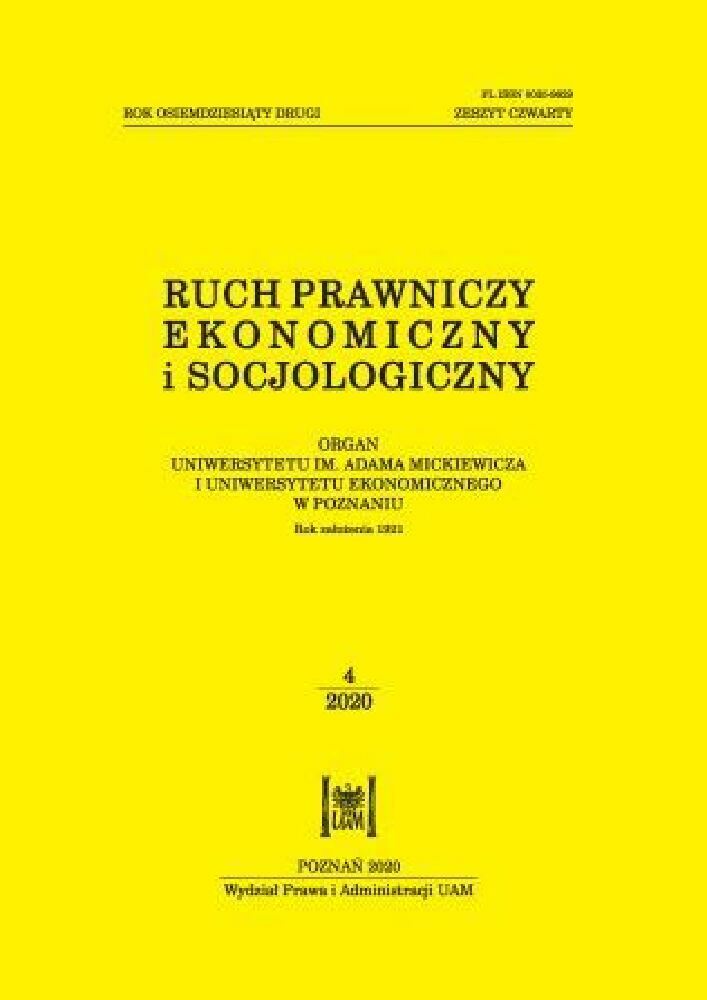Abstract
The development of financial markets over the past few decades highlighted the very important role of financial benchmarks, which are used as a reference price for financial instruments or to determine interest payments. However, after the global financial crisis, allegations emerged that interbank interest rate benchmarks had been manipulated. A significant decrease in the size and importance of unsecured interbank transactions was observed as well. Both elements lower the credibility of the interest rate benchmarks used thus far. With the responsibility for financial stability in mind, the European Parliament and the Council of the European Union adopted a regulation on benchmarks (BMR) in 2016. The main purpose of this paper is to verify the hypothesis of the occurrence of material change, which could undermine continued legal viability of interest rate benchmarks. The main subject of the analysis was the development of the EURIBOR and LIBOR methodology. The results of the analysis showed that the new waterfall methodology, which utilizes eligible interbank transaction data, transaction-derived data, and data-based expert judgement, is a robust evolution of the quote-based methodology. This means that administrators did not change the benchmark’s underlying interest, and no one should diagnose the risk to the continued legal viability of EURIBOR and LIBOR rates.
References
ARRC (2018). Second Report The Alternative Reference Rates Committee. <https://www.newyorkfed.org/medialibrary/Microsites/arrc/files/2018/ARRC-Second-report>.
Ashton, P., Chritophers, B. (2015). On arbitration, arbitrage and arbitrariness in financial markets and their governance: unpacking LIBOR and the LIBOR scandal. Economy and Society 44(2): 188–217.
Berman, B. (2015). How should structured product issuers and distributors respond to the IOSCO principles for financial benchmarks? The Journal of Investing 24(3): 107–115.
Bianchetti, M. (2013). Modern Pricing of Interest Rate Derivatives Including Funding and Collateral, [w:] M. Morinni, M. Bainchetti, Interest Rate Modelling after the Financial Crises, London: 113 – 152.
Chmielewski, T., Sławiński, A. (2010). Wykorzystanie instrumentów nadzorczych w polityce makrostabilnościowej, Zarządzanie Publiczne Nr 3(13): 49–66
Creel, J., Hubert, P., Viennot, M. (2016). The Effect of ECB Monetary Policies on Interest Rates and Volumes, Applied Economics 48: 4477 – 4501
Duffie, D., Stein, J.C. (2015). Reforming LIBOR and Other Financial Market Benchmarks, Journal of Economic Perspectives, 29 (2): 191–212
EBC (2018a). Update on quantitative mapping exercise: <https://www.ecb.europa.eu/paym/initiatives/interest_rate_benchmarks/WG_euro_risk-free_rates/shared/pdf/20180517/2018_05_17_WG_on_euro_RFR_Item_3_1_Mapping_exercise_ECB.pdf>.
Eisl, A., Jankowitsch, R., Subrahmanyam, M.G. (2017). The Manipulation Potential of Libor and Euribor. European Financial Management 23(4): 604–647.
EMMI (2017). Pre-Live Verification Program Outcome and Way Forward. <https://www.emmi-benchmarks.eu/assets/files/D0246B-2017_PLVP%20public%20report%20and%20way%20forward_FINAL.pdf>.
EMMI (2019). EURIBOR Benchmark Statement. <https://www.emmi-benchmarks.eu/assets/files/D0246A-2019-EURIBOR%20Benchmark%20Statement_final%20-%20FINAL.pdf>.
EMMI (2019b). Benchmarks Changes and Cessation Policy: <https://www.emmi-benchmarks.eu/assets/files/D0488D-2014-Benchmarks%20Changes%20and%20Cessation%20Policy.pdf>.
Ewerhart, C., Cassola, N., Ejerskov, S., Valla, N. (2007). Manipulation in money markets. International Journal of Central Banking 3(1): 113–148.
FSMA (2019). The FSMA Authorises EMMI as Administrator of the EURIBOR Benchmark. <https://www.fsma.be/en/news/fsma-authorises-emmi-administrator-euribor-benchmark>.
Georg, C.-P. (2011). The Effect of the Interbank Network Structure on Contagion and Financial Stability. Bundesbank Research Centre Discussion Paper Banking and Financial Studies No. 12.
Gruszczyńska-Brożbar, E. (1999). Rynek długoterminowych kapitałów pieniężnych w strukturze rynku kapitałów pieniężnych, Ruch Prawniczy, Ekonomiczny i Socjologiczny 61(3–4): 137–149
Gyntelberg, J., Wooldridge, P. (2008). Interbank rate fixings during the recent turmoil. BIS Quarterly Review, March: 59–72.
HM Treasury (2012). The Wheatley Review of LIBOR: final report. <https://www.gov.uk/government/uploads/system/uploads/attachment_data/file/191762/wheatley_review_libor_finalreport_280912.pdf>.
Hörth, E. (1998). New reference rates in EMU. Deutsche Bank Research – EMU Watch No. 60.
IBA (2017). ICE LIBOR Output Statement. <https://www.theice.com/publicdocs/ICE_LIBOR_Output_Statement.pdf>.
IBA (2018). ICE Benchmark Administration Becomes Authorised Benchmark Administrator Under EU Benchmark Regulation. <https://ir.theice.com/press/press-releases/all-categories/2018/04-30-2018-111621679>.
IBA (2019). ICE LIBOR – BMR Changes and Cessation Procedure. <https://www.theice.com/publicdocs/BMR_LIBOR_Change_Cessation_Procedure.pdf>.
Kapuściński, M., Kocięcki, A., Kowalczyk, H., Łyziak, T., Przystupa, J., Stanisławska, E., Sznajderska, A., Wróbel, E. (2016). Mechanizm transmisji polityki pieniężnej w Polsce. Co wiemy w 2015 roku? Materiały i Studia 323. Warszawa.
Klein, P. (2004). Interest rate swaps. Reconciliation of models. The Journal of Derivatives 12(1): 46–57.
Lubiński, M. (2013). Międzybankowy rynek pieniężny i zarażenie. Gospodarka Narodowa 83/24(5/6): 19–41.
Martin, R. (2013). After economy? Social logics of the derivative. Social Text 31(1): 83–106.
McBride, J. (2016). Understanding the Libor Scandal. <https://www.cfr.org/backgrounder/understanding-libor-scandal>.
Mielus, P. (2016). Dylematy reformy indeksów rynku finansowego. Gospodarka Narodowa 86/27(4): 91–114.
Mishkin, F.S., Eakins, S.G. (2015). Financial Markets and Institutions. Harlow.
Mollenkamp, C., Whitehouse, M. (2008). Study casts doubt on key rate. Wall Street Journal, 28 May 2008. <https://www.wsj.com/articles/SB121200703762027135>.
MPG (2014). Market Participants Group on Reforming Interest Rate Benchmarks Final Report. <https://www.fsb.org/wp–content/uploads/r_140722b.pdf>.
Nawrot, W. (2008). Rynek kapitałowy i jego rozwój. Warszawa.
Penczar, M. (2017). Consumer Characteristics with Regard to Choosing Between Fixed and Adjustable
Interest Rates in Mortgage Contracts, Bezpieczny Bank 4(69): 131–146.
Tabb, R., Grundfest, J. (2013). Alternatives to LIBOR. Capital Markets Law Journal 8(3): 229–260.
Vaughan, L., Finch, G. (2017). The Fix: How Bankers Lied, Cheated and Colluded to Rig the World’s Most Important Number. Chichester.
License
Copyright (c) 2020 WPiA UAM

This work is licensed under a Creative Commons Attribution-NonCommercial-NoDerivatives 4.0 International License.





